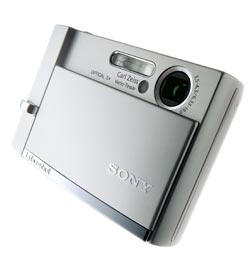

 Sanyo's latest Xacti gives High Def in your pocket. Mark Harris explores
a brave new high res world...
Sanyo's latest Xacti gives High Def in your pocket. Mark Harris explores
a brave new high res world... Kit: Sony Cyber-shot DSC-T30 digital camera
Cost: £350
Company: Sony www.sony.co.uk
With the digital camera market as saturated as it is, it can be tempting to
dismiss whole ranges (and occasionally even entire brands) as too cheap or under-specified
to be worth considering. Sony’s T-series cameras have always been slick
and stylish, but only recently have they started to offer features – such
as high sensitivity and optical stabilisation - that broadens their appeal beyond
a point-and-shoot audience.
With its huge slide-down lens cover and corner-mounted lens, the T30 is instantly
identifiable as a Sony. Build quality is uniformly excellent, from an all-metal
case and huge 3-inch screen right down to chromed metal buttons. The T30 is noticeably
plumper and heavier than its predecessor, the T9, but can still slip comfortably
into a jacket pocket.
The Cyber-shot powers up in around a second and uses a single menu bar that couldn’t
be easier or faster to navigate. Some of that speed fades away with the Carl Zeiss
lens, which putters rather than zooms through its modest 3x range. Other controls
are precise but on the small side, especially the four-way menu pad.
The entire rear of the T30 is covered by a sheet of polycarbonate. That’s
great for design (and for protecting the LCD) but it attracts smears and fingerprints
like you wouldn’t believe – keep a cloth handy at all times. The screen
itself gains half an inch on the T9’s display but has no more pixels. It’s
sharp enough for framing and playback, and you can boost the screen’s brightness
easily without trawling through menus, by holding down the display button.
But it’s really dim conditions that the T30 has been designed for. The first
line of defence is Sony’s Super SteadyShot optical stabiliser, which does
a fine job of banishing blur (if still not quite up to the ultimate stability
of Panasonic’s OIS system). Next up is improved sensitivity, which reaches
a healthy ISO 1000 while keeping both colour and luminance noise tightly under
control. You do sacrifice contrast and tonal vitality, though, so beware when
shooting low light portraits, which can emerge rather ashen. The built-in flash
is also worth a mention, as it pumps out a surprisingly quantity of light for
such a slim unit, serving up rich, natural colours.
Full house
Despite lacking manual exposure, there’s a good range of other creative
features on board. Focusing is especially well served, with multi and spot modes,
plus presets for grabbing snaps in tricky conditions. The autofocus system isn’t
the fastest we’ve used but rarely makes mistakes – and can focus as
close as 1cm in Magnifying Glass mode (just hit the Macro button twice). Colour,
sharpness and contrast are easily tweaked, too. Drive modes include exposure bracketing
and an average 1fps burst mode.
Sony has always been good on the power side, and the T30 has its usual smart battery
that lets you know how much time you have left, rather than the less helpful ‘number
of shots’ display on rival cameras. You should expect over three hours of
operation from a single charge.
Small, folded optic lenses don’t always produce the strongest results, but
it’s amazing how much sheer information the T30 extracts from its tiny corner-mounted
zoom. The seven megapixel chip hoovers up sharp edges and fine detail, matching
it with crisp, natural colours and spot-on metering. There’s a hint of softness
and some light distortion at the edges but little enough to complain about for
a pro-sumer model, let alone a lifestyle snapper. You can supposedly use the SteadyShot
stabiliser on the bold, smooth movies, too, but you’ll hardly notice the
difference unless you’re already very steady of hand.
Sony’s T-series is maturing very nicely. The T30 remains graceful and straightforward
to use, while upgrades to resolution, low light shooting and battery life lift
it up a level from its forerunners. An excellent all-round compact that promises
even better to come.
Verdict
Features:
A middle-of-the-road specification (3x lens, 7MP chip) is enlivened by good low
light shooting and a spread of manual tweaks 3/5
Performance
Extremely impressive performance from such a small lens. Images are rich, natural
and above all, sharp, and movies look nice, too 4/5
Handling
You’ll struggle to find a competent camera that’s easier to use, although
the zoom is sluggish and some of the controls are small 4/5
Build quality:
There’s isn’t a duff component on board the T30. The screen is large
and (just) bright enough, the lens is sharp and the metal body is solid 5/5
Value for money:
You don’t look to Sony for bargain basement buys but it’s not over-priced
when you consider the care and attention that’s been lavished upon it 4/5
Overall Verdict
It’s refreshing to see a range really progress. The latest T-series is smarter,
tougher and easier to use than its predecessors, although also a little heavier
on the pocket (and wallet). Image quality is wonderful for the size and there
are enough features to keep your mind as well as your eye engaged.
82%
Rivals
Name: Panasonic Lumix FX-01, Price: £300
A megapixel less but sporting a fantastic 28mm equivalent wideangle setting, the
FX01 exudes class and sophistication.
DCAM score 90%
Name: Canon Digital Ixus 65, Price: £ RRP not street price
Nigh on perfect 6MP point-and-shoot camera, although ISO 800 gets a bit noisy.
Excellent build quality.
DCAM score 85%